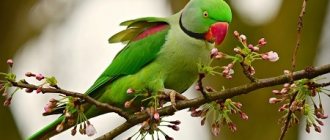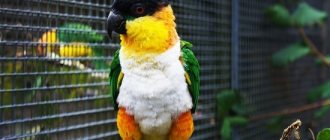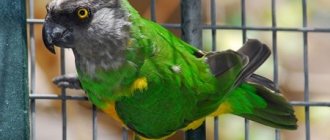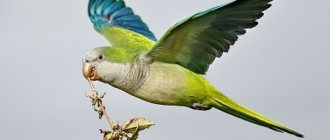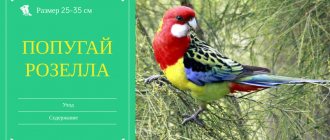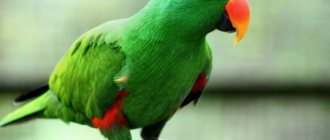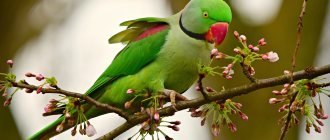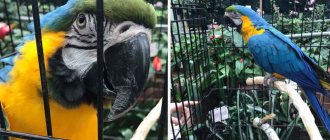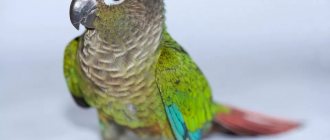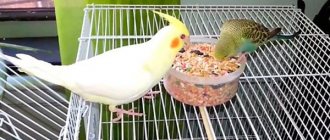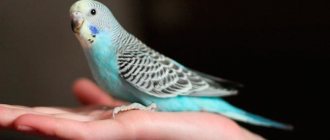Alexandrian parrots are large, well-proportioned birds with a bright, rounded beak and green plumage. During the time of Alexander the Great, they were valued more than strong, healthy slaves and were kept in gilded cages. Now smart and graceful birds have lost their former popularity and are known to a narrow circle of specialists.
Let's find out what Alexander's ringed parrot looks like and what the specifics of its maintenance are.
Description
The bird's extraordinary mental abilities, external beauty and inner peace of mind will not leave anyone indifferent. Alexandrian parrots in nature very rarely fall to the ground, preferring to stay away from humans. And when a family member sits on the owner’s arms or lap to watch TV with you, you understand that this is happiness.
The bird was named in honor of the famous commander. From reliable historical sources it follows that in the 4th century BC, the army of Alexander the Great brought these pets to Greece. From the Balkan Peninsula, birds migrated to other countries as expensive gifts as a sign of respect and veneration. And this is not surprising.
Differences from the necklace parrot
Alexandrov ringed belongs to the same genus as the ringed one. It lives in approximately the same areas and at a young age can easily pass for a necklace. However, in comparison with it, the Alexandrian parrot has a number of distinctive features.
- The main part of its body is covered with green feathers. Whereas the necklace can be colored red, blue, blue, white or yellow.
- These birds can be distinguished not only visually, but also by behavior. The necklace parrot is difficult to tame, has no special ability to copy human speech and is not recommended for home keeping.
Necklace parrots
Appearance
Alexandrian parrots have a spectacular appearance, royal bearing and innate grace. This arouses genuine interest and respect even among the most sophisticated breeders. As you know, the green tone can lift your spirits.
- Starting from grassy-malachite and ending with emerald-pistachio, the entire palette of colors adorns the body of the bird.
- The upper part of the wings is decorated with brown and burgundy spots, the neck is covered with a pink and red “necklace”. Such jewelry is typical only for males, and then only by the age of three. Nature has deprived the female sex of such decoration.
- The solid body is completed by a large head with a massive bright scarlet beak. In young individuals it is yellow-orange.
- The magnificent tail, which is almost the same length as the body, deserves special attention. The maximum size of the bird reaches 60 cm.
Price and nuances of choice
The cost of necklace parrots is relatively low. A large representative of the ringed genus, the Alexandrian parrot, can be bought for 25,000-38,000 rubles at a pet store. You can find out how much a fosterling from a nursery costs on the websites of professional breeders. Internet monitoring shows that the price starts from 50,000 rubles. The final amount depends on the color, gender, age and how tame the chick is.
When choosing a pet, first of all take a closer look at its behavior. If the bird is energetic, sociable, does not hide, and allows itself to be stroked, this is a suitable “specimen”. Look into the parrot's eyes - the chick's eyes should be black, but as they grow older, the iris will acquire a light shade. You should not take a chick that is too young - most likely, difficulties will arise with feeding. The optimal age for purchase is 2 months.
Calm, good-natured towards people, the ringed Alexandrine parrot is not often found among breeders. This is due to the fact that the bird is large and has a loud voice. But in general, an exotic pet does not cause any special problems, and communication with it gives a lot of pleasant emotions.
Character
And if you add a balanced and good-natured disposition to this, you will get not a pet, but a dream. The Alexandrian necklace parrot easily gets used to people, but they become attached to only one. The animal is quite capricious. Showing character without paying attention to the owner is quite in his spirit. The birds themselves determine when to caress and when to bite. At such moments, it is better to leave him alone and wait. Time will pass and everything will flow in the same direction.
To prevent this from happening often, it is necessary to competently and methodically raise your pet. It is better to purchase a bird before five months of age. The older an individual is, the harder it is to tame, train and re-educate it. At first, a wild parrot will behave warily, refusing to eat. Only when it feels that there is no threat will the bird calm down and demonstrate contentment and comfort with its entire appearance. And from now on you become a constant object of attention, activities and games.
An important aspect of training is the moment of completely ignoring the wrong behavior of the bird. Leave the cage only when the owner allows it, do it yourself if the breeder is busy. Otherwise, the decoration of a human home will turn into crumbs. To avoid this, skillful and competent owners set up wooden stands with an abundance and variety of homemade entertainment and toys. Lack of interest and care on the part of humans can turn a gentle animal into an aggressive and uncontrollable creature. If you don’t have enough free time, it’s better not to purchase such a breed.
Lifespan
According to numerous studies, the average life expectancy of feathered pets directly depends on the species characteristics. Necklace parrots, provided they are properly maintained and fed properly, can live thirty years or even more in captivity.
This is interesting! A young ring-necked parrot can be identified by its paler plumage than the adult bird's feathers.
The beak has a pinkish-red color. From about the age of six months, an orange edging characteristic of the species appears around the eyes of the necklace parrot. At the age of twelve months, after molting, males acquire a barely noticeable and fairly thin necklace, which is fully formed by about three years.
Habitat
Alexander's ringed parrot inhabits the humid forest zones of India, Pakistan, Myanmar, Laos, and Afghanistan. The geography of distribution depends on the subspecies, there are five in total. They live in the tops of tropical thickets, occasionally visiting the ground. Good sprinters, but only fly short distances.
They often become uninvited guests of agricultural plantations, destroying young corn grains. They live in small flocks, from eight to two dozen individuals. When free from flying, they prefer to hide in the thickets of trees. At night, the thickets are occupied by huge hordes, the size of which can reach thousands. During the breeding season they exist in pairs, taking a liking to tree hollows.
What does the future owner of an exotic parrot need to know?
In 1973, the Convention (CITES) concerning the strict regulation and international trade of endangered species of wild flora and fauna was signed in Washington. Russia is also a member of CITES.
The first CITES appendix lists 42 species of parrots: 12 Amazons, 7 Macaws and 4 Cockatoos. The exception is birds bred under artificial conditions in the second generation.
The second appendix contains the remaining species of parrots, the international trade of which is permitted subject to special permission from the exporting country. Cockatiels, ringnecked parrots and budgies are not classified under any CITES appendix.
- Why does a cat need a mustache?
- Rescue dogs
- Hypoallergenic cats
- Why does a cat need a tail?
- Chinchilla
- Dog breeds
What documents should there be for parrots:
- first and foremost it should be CITES;
- a copy of the veterinary certificate for poultry from the exporting country;
- original veterinary certificate, which is issued by the airport veterinary service upon entry;
- tests for: salmonellosis, psittacosis, bird flu, Newcastle disease. These tests must be from both the sending country and the receiving country of the bird in which it has undergone a thirty-day quarantine!
- official permission from Rosselkhoznadzor to import parrots into Russia.
- the seller must be registered in the Argus electronic system. Without registering it with Argus, it is impossible to introduce a bird from abroad.
Keeping at home
An active and curious bird, it is a very hardy and unpretentious creature. They feel great both in ordinary apartments and in spacious outdoor enclosures. But for a more comfortable stay, a private house is best suited. The Alexandrian parrot has a loud and creaky voice. Not all neighbors will be happy.
Cell
It is best to house a fairly large bird in large houses. Too small spaces cause discomfort in the pet, and the bird may become sad and later get sick. The cage must be all-metal and spacious, at least one and a half meters in height and width. Because almost everything is tested for strength. Therefore, wooden perches and natural branches become an integral element of the interior decoration of the home.
A swimsuit will help you get as close to natural habitat conditions as possible. At home, lovers of water treatments love to swim in the pouring rain. Although individuals are quite tolerant of temperature changes, it does not hurt to clean their feathers and wash them in warm water. They don’t like drafts, and they tolerate zero marks on the thermometer steadfastly.
Birds are partial to all kinds of entertainment and games. They prefer various toys, but it is worth noting that they quickly become boring. Therefore, it is necessary to either swap them or remove them for a while.
Freedom for parrots
It is worth noting that in order to prevent organ atrophy and avoid obesity, it is recommended to let fidgets out of the cage daily. Therefore, when buying a bird, you need to take into account the size of your living space. The wingspan of the Alexandrov ringed parrot reaches 20 cm.
Diet
It is recommended to feed granivorous birds with special mixtures, purchased in a store or made independently. The most common pet products:
- pre-soaked peas, corn, barley and wheat;
- sunflower seeds, oats and millet;
- Vegetables, fruits and nuts are recommended as supplements;
- Eggs and white bread soaked in water will not be superfluous.
Attention! Researchers have long noted that the favorable life of the Alexandrov ringed parrot in captivity is also influenced by a varied and fortified diet.
Breeding
At home, such birds rarely have offspring. Carefully choosing pairs in nature, people do this at home. Often such attempts remain unsuccessful. If the matchmaking was successful, then courtship begins by January.
For fruitful reproduction of Alexandrine parrots, artificial nests are arranged. The bottom is covered with a peat mixture with sawdust and after 25 days feathered babies may appear here. The Alexandrine parrot chicks are incubated by the female, while the father cares for and feeds the family. A union may produce from 2 to 4 completely white eggs. Upon reaching two months, the offspring become independent. At this time they should be transplanted into another cage.
Parrot diseases and prevention
Necklace parrot chicks are more susceptible to disease. In a brood of ringed parrots, chicks with “frog legs” may appear, which are cramped or are distinguished by turning outward. The anomaly is caused by disturbances in the activity of the nervous system, which is caused by a lack of vitamins belonging to group “B”. Such chicks are not subject to treatment.
For preventive purposes, it is necessary to clean breeding premises daily, thoroughly rinse feeders and drinkers, and treat baths and perches. In nesting areas, it is important to maintain a certain temperature regime and completely eliminate any drafts.
Cost and purchase of a chick
A ringed parrot (ringed, Alexandrian) in pet stores and markets costs from 5,000 to 10,000 rubles. In nurseries prices are higher: from 8,000 to 20,000 rubles.
You can buy it both in a specialized nursery and in a regular pet store (unlike, for example, the same Gray, which can only be bought from professional breeders).
Before purchasing, please note that if you want to teach your parrot to speak, then:
- It must be a very young chick (about 7 weeks old);
- He must be alone.
The most grown-up birds can do is learn to imitate a whistle, a dog barking, or simply confusion. If a parrot has a pair, then it simply will not focus on learning. If you follow both rules, then your feathered beauty will be able to learn up to 60 words, or even more.
After choosing a nursery or an experienced, well-established breeder, you need to make a careful visual inspection of the purchased bird:
- the plumage of a healthy ringed parrot should be smooth and shiny, close-fitting;
- brittle or damaged feathers may indicate that your pet is infected with parasites;
- contamination of plumage with feces in the cloaca area is usually the main symptom of intestinal diseases;
- if the plumage is dirty in the area of the chest or crop, then it can be assumed that it is infected with an infectious disease of the crop.
It is best to purchase a young chick no older than one and a half months. When buying a grown bird, the most you can hope for is to teach your pet to imitate whistling or inarticulate sounds.
Important! When examining the beak, ears and eyes, abscesses and tumors, fresh or dried secretion products, and damage by scabies mites should not be detected.
Parrots kept in pairs often cannot concentrate on the learning process, but a good, correctly chosen bird can easily learn more than fifty words.
And the main rule is to love your pet, take care, pay attention, and he will respond in kind throughout his life.
Owner reviews
Kerin707
Advantages : active, easily tamed at an early age, cheerful and funny, beauty, can be taught to follow commands, intelligence
Disadvantages : very high-pitched screams
Bonya appeared with us about 7 years ago. And for the first four years (now he has grown up and become more serious), there were many problems with him. The bird is restless (to put it mildly). He wants to be everywhere at once, gets in the way, climbs wherever he can, steals food, constantly climbs towards flowers, as well as towards you, especially when you are eating :)
The biggest minus of the necklace: its “beautiful singing”. He screams piercingly, and also growls. Sometimes he can purr sweetly, but only if you deserve his kindness. Another negative: he doesn't speak. But it can be trained, it’s just much more difficult than some other breeds. Well, the last minus of my bird personally: he is terribly paranoid. We have been living together for 7 years, he eats from my hands, knows all the family members by sight, but still believes that deep down we are planning to kill him. For example, when I take away the food, Bonnie begins to have a fit (will he starve?), and when I clean the cage and take out the tray, he begins to thrash around and scream madly. We are afraid of many things: a vacuum cleaner, a broom, a mop, rustling bags, etc. But I think this is an individual character trait of my bird :)
And now about the advantages and talents.
He can be nice. Rarely, but maybe. This usually happens when he has had enough fun and food. Then he sits peacefully on your shoulder, fluffed up, and quietly purrs in your ear. And you can’t even tell that only recently this bird was rushing around the room in circles looking for something to destroy and break.
Now Bonya is no longer as mad as before. He is much calmer, no longer breaks everything in his path, doesn’t get into his mouth when someone is eating, and doesn’t even pull out the feeder when you try to change the food. Unfortunately, he is currently ill and has also suffered a wing injury and is barely patching up.
MoRoK
Advantages : cheerful and funny, beauty, intelligence
Disadvantages : difficult to tame
We bought her secondhand; the former owner said that she was 8 months old and no longer a chick. For some reason he thought it was a male, so we named him Arkasha. The necklace never showed up, so now it's Arcadia. In general, we still say either “she” or “he”, but I think she doesn’t care.
Once in my childhood I had a budgerigar, and, in general, that was the end of my bird-keeping experience, but my husband and I decided to take a risk.
I’ll say right away that the difference with the wavy is simply huge! Ozherelik, if I may say so, is smarter, even more interesting to watch, but he is more difficult to tame.
Screams. Yes, he screams loudly, VERY loudly. Our guests are scared at first. The voice is never angelic. Ours, when it’s sunny in the summer, begins to “welcome a new day” at dawn, around 6 in the morning. We sleep in another room, the walls are thick in the house, the doors are tight, so it doesn’t bother us or our neighbors, but in a panel house it would probably be terrible. They say it can be weaned, but raising a necklace is not an easy matter.
Many people complain that necklaces chew furniture a lot. We were somehow lucky; she mostly chews on her toys and perches. But its beak is powerful, so the damage can be really great. In general, if in doubt, it is better not to get one, and not to torture yourself or the bird.
Violetta01
Advantages : active, cheerful and funny, sudden happiness, beauty, intelligence
Disadvantages : garbage
They decided to buy it spontaneously at the poultry market for 5,000 rubles. (If I had initially read the reviews, I would not have gone there for such a purchase) fortunately the parrot is healthy and active. Why this price? I don't know. After the purchase, we came several times and talked with the man who sells them. Quite decent. He knows a lot about parrots; he has a lot of species for sale. The prices are incredible.
They chose a boy based on general characteristics, and the seller helped as best he could. They named him Yasha.
I can't say that my love for birds is not great, I am a cat lover. But love for him grew every day. And he's just amazing. He screams loudly, but not often, so I won’t write this down as a disadvantage. I once had budgies, but this one is much more interesting to watch. We love him madly. Start it, don't be afraid of anything. The main thing is attention. The more you give to the bird, the more it will give in return.
BreatheWithMe
Advantages : beauty, intelligence
Disadvantages : trash, high-pitched screams, difficult to tame
Ozherelov certainly have a lot of advantages - they are bright, attractive birds, quite smart and quick-witted, sociable, but only if they are tame. Otherwise, the pet will not bring you any joy - only garbage and shrill screams (and oh, what a ringing voice they have).
Therefore, if you are planning to get yourself an Ozherelov, then be sure to: take a young bird (a young one is still easier to tame and teach to talk), be very patient, especially if the bird is wild, be prepared for a ringing loud voice, endless garbage. I strongly advise you to take a more or less tame chick, pay attention to the breeder, talk to him about this topic. Especially if you have little free time and little patience for that. to train a bird for months.
